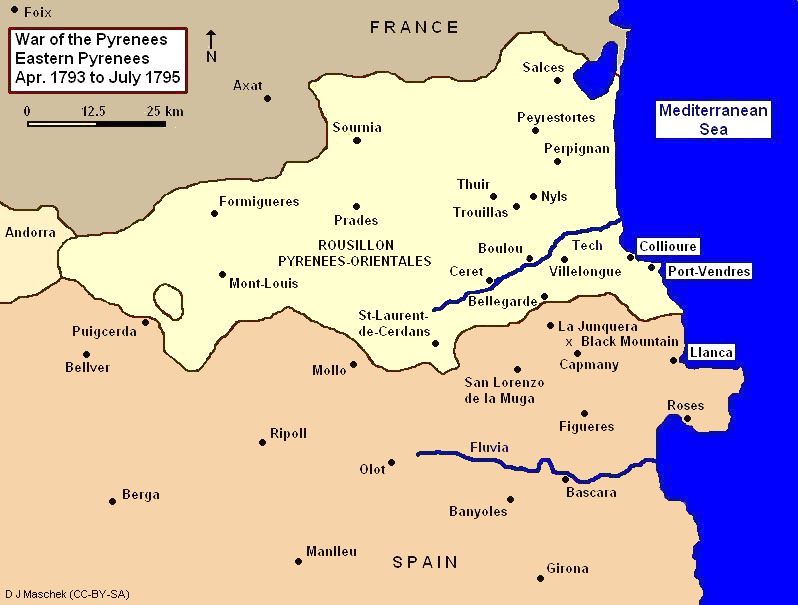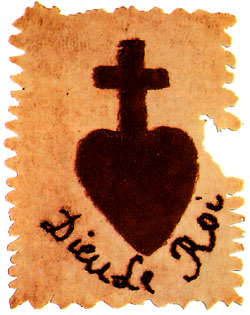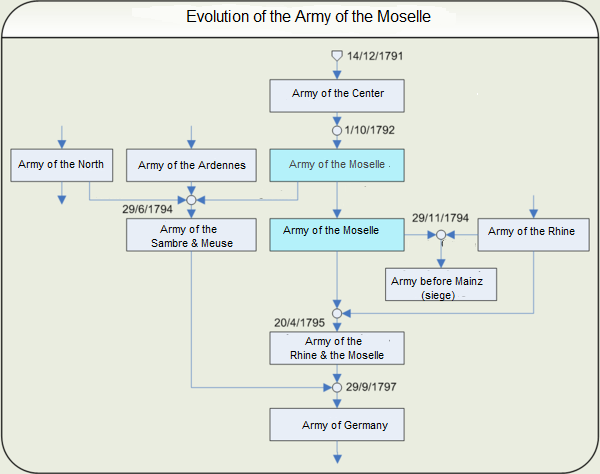|
Louis Marie Turreau
Louis-Marie Turreau (4 July 1756, Évreux, Eure – 10 December 1816, Conches), also known as ''Turreau de Garambouville'' or ''Turreau de Linières'', was a French general officer of the French Revolutionary Wars. He was most notable as the organiser of the colonnes infernales during the war in the Vendée, which massacred tens of thousands of Vendéens and ravaged the countryside. He attained army command, but without notable military accomplishments. Under the First French Empire, he pursued a career as a high functionary, becoming ambassador to the United States then a Baron of the Empire. Life Early life Louis-Marie Turreau's father was fiscal procurator for waters and forests to the comté d'Évreux, before becoming mayor of Évreux. This situation imparted certain privileges to the Turreau family, even though they were not nobles. Turreau was nevertheless a fervent revolutionary from 1789, profiting like many others, especially the bourgeois of that era. Elected mayo ... [...More Info...] [...Related Items...] OR: [Wikipedia] [Google] [Baidu] |
Louis Hersent
Louis Hersent (10 March 1777 – 2 October 1860) was a French painter. Life and career He was born in Paris. He became a pupil of Jacques-Louis David, and obtained the Prix de Rome in 1797. In the Salon of 1802, he showed ''Metamorphosis of Narcissus'', and he continued to exhibit with rare interruptions up to 1831. He married Louise-Marie-Jeanne Mauduit in 1821. His pupils were Louis-Eugène Bertier, Auguste Bigand, Hélène Charlotte Juliette de Bourge, Augustin Luc Demoussy, Henri Joseph Constant Dutilleux, Hippolyte Dominique Holfeld, Jean-Francois-Hyacinthe-Jules Laure, Eugène Modeste Edmond Lepoittevin, Emile Aubert Lessore, Auguste Dominique Mennessier, François Alexandre Pernot, Julie Philipault, August Thomas Pierre Philippe, Pierre Poterlet, Joachim Sotta, Henry de Triqueti, and Théophile Auguste Vauchelet. His most considerable works under the First French Empire were ''Achilles parting from Briseis'', and ''Atala dying in the arms of Chactas'' (b ... [...More Info...] [...Related Items...] OR: [Wikipedia] [Google] [Baidu] |
Colonnes Infernales
The infernal columns (French: ''colonnes infernales'') were operations led by the French Revolutionary general Louis Marie Turreau in the War in the Vendée, after the failure of the Royalist Virée de Galerne. Following the passage on 1 August 1793 and 1 October 1793 by the National Convention of laws, the National Convention stated that the goal was to exterminate "brigands" in the area south of the river Loire (the so-called Vendée), 12 army columns were formed and sent through the Vendée to exterminate the local anti-Republican population. In January 1794, Turreau wrote to the National Convention's Minister for War, to lay out his proposed tactics: "My purpose is to burn everything, to leave nothing but what is essential to establish the necessary quarters for exterminating the rebels." It has been estimated that from 16,000 to 40,000 inhabitants were killed during the first quarter of 1794. Nicolas Delahaye et Pierre-Marie Gaborit, ''Les 12 Colonnes infernales de Turreau'' ... [...More Info...] [...Related Items...] OR: [Wikipedia] [Google] [Baidu] |
Army Of The Eastern Pyrenees
The Army of the Eastern Pyrenees (''Armée des Pyrénées Orientales'') was one of the French Revolutionary armies. It fought against the Kingdom of Spain in Roussillon, the Cerdanya and Catalonia during the War of the Pyrenees. This army and the '' Army of the Western Pyrenees'' were formed by splitting the original ''Army of the Pyrenees'' at the end of April 1793 soon after the war started. Shortly after the Peace of Basel on 22 July 1795, the fighting ended and the army was dissolved on 12 October that same year. Many of its units and generals were transferred to join the '' Army of Italy'' and fought under Napoleon Bonaparte in 1796. In the first dismal months of fighting, the ''Army of the Eastern Pyrenees'' was beaten at Mas Deu and Bellegarde and forced back under the walls of Perpignan. Then the French repelled two Spanish attacks at Perpignan and Peyrestortes. Though the army was defeated again at Truillas and in other actions, the Spanish invaders withdrew to the ... [...More Info...] [...Related Items...] OR: [Wikipedia] [Google] [Baidu] |
Vendée
Vendée (; br, Vande) is a department in the Pays de la Loire region in Western France, on the Atlantic coast. In 2019, it had a population of 685,442.Populations légales 2019: 85 Vendée INSEE Its prefecture is . History The area today called the Vendée was originally known as the ''Bas-Poitou'' and is part of the former province of . In the southeast corner, the village of |
Poitou
Poitou (, , ; ; Poitevin: ''Poetou'') was a province of west-central France whose capital city was Poitiers. Both Poitou and Poitiers are named after the Pictones Gallic tribe. Geography The main historical cities are Poitiers (historical capital city), Châtellerault (France's kings' establishment in Poitou), Niort, La Roche-sur-Yon, Thouars, and Parthenay. History A marshland called the Poitevin Marsh (French ''Marais Poitevin'') is located along the Gulf of Poitou, on the west coast of France, just north of La Rochelle and west of Niort. At the conclusion of the Battle of Taillebourg in the Saintonge War, which was decisively won by the French, King Henry III of England recognized his loss of continental Plantagenet territory to France. This was ratified by the Treaty of Paris of 1259, by which King Louis annexed Normandy, Maine, Anjou, and Poitou). During the late sixteenth and early seventeenth centuries, Poitou was a hotbed of Huguenot (French Calvinist Protestan ... [...More Info...] [...Related Items...] OR: [Wikipedia] [Google] [Baidu] |
Army Of The Coasts Of La Rochelle
The Army of the Coasts of La Rochelle (french: Armée des côtes de La Rochelle) was an army of the French Revolution which was created on 30 April 1793 and responsible for defending a region from the mouth of the Loire River south to the Gironde. Despite its relatively short existence, the army fought numerous battles during the War in the Vendée including Thouars, Fontenay-le-Comte, Saumur, First Châtillon, Vihiers, Luçon, Chantonnay, Coron and Saint-Fulgent. Many of the battles resulted in Republican defeats at the hands of the Vendean Royalists. Of the two principal army commanders, Armand Louis de Gontaut, Duke of Biron was dismissed and later executed by guillotine while Jean Antoine Rossignol was a political appointee who was generally acknowledged to be incompetent. The army was absorbed by the '' Army of the West'' on 5 October 1793. History Creation and evolution The ''Army of the Coasts of La Rochelle'' traced it existence to the ''Army of the Interior'' which b ... [...More Info...] [...Related Items...] OR: [Wikipedia] [Google] [Baidu] |
Army Of The Moselle
The Army of the Moselle (''Armée de la Moselle'') was a French Revolutionary Army from 1791 through 1795. It was first known as the ''Army of the Centre'' and it fought at Valmy. In October 1792 it was renamed and subsequently fought at Trier, First Arlon, Biesingen, Kaiserslautern, Froeschwiller and Second Wissembourg. In the spring of 1794 the left wing was detached and fought at Second Arlon, Lambusart and Fleurus before being absorbed by the ''Army of Sambre-et-Meuse''. In late 1794, the army captured Trier and initiated the Siege of Luxembourg. During the siege, the army was discontinued and its divisions were assigned to other armies. History Originally known as the ''Army of the Centre'', it was renamed by decree of the National Convention on 1 October 1792 and kept under that name in the decrees of 1 March and 30 April 1793. By the decree of 29 June 1794 its left wing joined with the ''Army of the Ardennes'' and the right wing of the ''Army of the North'' to form the ... [...More Info...] [...Related Items...] OR: [Wikipedia] [Google] [Baidu] |
National Guard (France)
The National Guard (french: link=no, Garde nationale) is a French military, gendarmerie, and police reserve force, active in its current form since 2016 but originally founded in 1789 during the French Revolution. For most of its history the National Guard, particularly its officers, has been widely viewed as loyal to middle-class interests. It was founded as separate from the French Army and existed both for policing and as a military reserve. However, in its original stages from 1792 to 1795, the National Guard was perceived as revolutionary and the lower ranks were identified with sans-culottes. It experienced a period of official dissolution from 1827 to 1830 but was reestablished. Soon after the Franco-Prussian War of 1870–71, the National Guard in Paris again became viewed as dangerously revolutionary, which contributed to its dissolution in 1871. In 2016, France announced the reestablishment of the National Guard for the second time, in response to a series of te ... [...More Info...] [...Related Items...] OR: [Wikipedia] [Google] [Baidu] |
Abbaye De Conches
An abbey is a type of monastery used by members of a religious order under the governance of an abbot or abbess. Abbeys provide a complex of buildings and land for religious activities, work, and housing of Christian monks and nuns. The concept of the abbey has developed over many centuries from the early monastic ways of religious men and women where they would live isolated from the lay community about them. Religious life in an abbey may be monastic. An abbey may be the home of an enclosed religious order or may be open to visitors. The layout of the church and associated buildings of an abbey often follows a set plan determined by the founding religious order. Abbeys are often self-sufficient while using any abundance of produce or skill to provide care to the poor and needy, refuge to the persecuted, or education to the young. Some abbeys offer accommodation to people who are seeking spiritual retreat. There are many famous abbeys across the Mediterranean Basin and Europe ... [...More Info...] [...Related Items...] OR: [Wikipedia] [Google] [Baidu] |
Aviron
Aviron () is a commune in the Eure department in Normandy in northern France. Population See also *Communes of the Eure department The following is a list of the 585 communes of the Eure department of France. The communes cooperate in the following intercommunalities (as of 2020):Communes of Eure {{Eure-geo-stub ... [...More Info...] [...Related Items...] OR: [Wikipedia] [Google] [Baidu] |
Comté D'Évreux
''Comte'' is the French, Catalan and Occitan form of the word 'count' (Latin: ''comes''); ''comté'' is the Gallo-Romance form of the word 'county' (Latin: ''comitatus''). Comte or Comté may refer to: * A count in French, from Latin ''comes'' * A county in France, that is, the territory ruled by a count * La Comté, a commune in the Pas-de-Calais département of France * Comté cheese, a French cheese from Franche-Comté People with the surname * Alfred Comte (1895–1965), Swiss aviation pioneer * Auguste Comte (1798–1857), French philosopher * Charles Comte (1782–1837), French lawyer, journalist and political writer * Claudine le Comte (born 1950), Belgian fencer * Fabienne Comte, French statistician * Fernando Compte (1930–2013), founder and first president of the International Sambo Federation * Ferran Soriano i Compte (born 1967), Spanish CEO of various football clubs, including Manchester City F.C. * Harry Comte (1909—1945), Australian rules footballer * Louis Co ... [...More Info...] [...Related Items...] OR: [Wikipedia] [Google] [Baidu] |
Nobility Of The First French Empire
As Emperor of the French, Napoleon I created titles of nobility to institute a stable elite in the First French Empire, after the instability resulting from the French Revolution. Like many others, both before and since, Napoleon found that the ability to confer titles was also a useful tool of patronage which cost the state little treasure. In all, about 2,200 titles were created by Napoleon: * Princes and Dukes: **Princes of the Imperial family ***The Imperial Prince (Napoleon's son, Napoleon II) ***Princes of France (8 close family members) ** sovereign princes (3) ** duchies grand fiefs (20) ** victory princes (4) ** victory dukedoms (10) ** other dukedoms (3) * Counts (251) * Barons (1,516) * Knights (385) Napoleon also established a new knightly order in 1802, the Légion d'honneur, which is still in existence today. The Grand Dignitaries of the French Empire ranked, regardless of noble title, immediately behind the Princes of France. Creation Ennoblement started in 18 ... [...More Info...] [...Related Items...] OR: [Wikipedia] [Google] [Baidu] |




